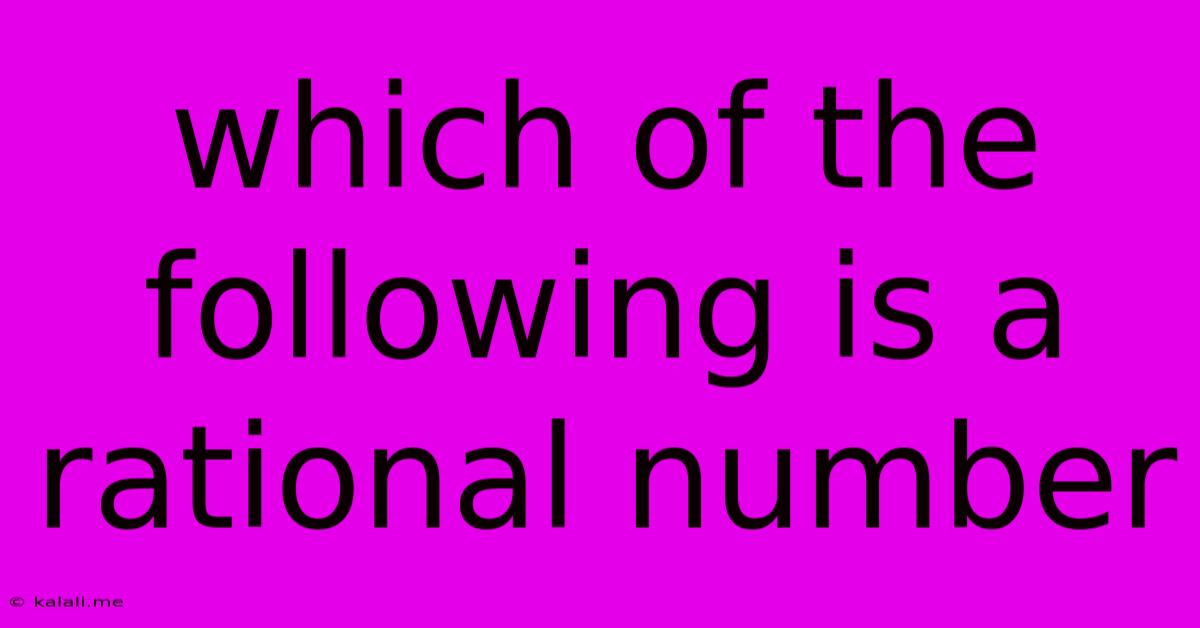Which Of The Following Is A Rational Number
Kalali
Jun 13, 2025 · 3 min read

Table of Contents
Which of the Following is a Rational Number? A Comprehensive Guide
Meta Description: Confused about rational numbers? This guide clearly defines rational numbers, provides examples, and helps you identify them from a given set. Learn the difference between rational and irrational numbers with simple explanations and practical examples.
Rational numbers are a fundamental concept in mathematics, forming the basis for many advanced mathematical operations. Understanding what constitutes a rational number is crucial for anyone studying mathematics or related fields. This article will define rational numbers, provide examples, and guide you through identifying them within a set of numbers.
What is a Rational Number?
A rational number is any number that can be expressed as the quotient or fraction p/q of two integers, a numerator p and a non-zero denominator q. In simpler terms, it's any number that can be written as a fraction where both the top and bottom numbers are whole numbers (integers), and the bottom number isn't zero.
Key characteristics of a rational number:
- It can be expressed as a fraction (p/q).
- The numerator (p) and the denominator (q) are integers.
- The denominator (q) is not equal to zero (q ≠ 0).
Examples of Rational Numbers
Many numbers you encounter daily are rational numbers. Here are some examples:
- Integers: All whole numbers, both positive and negative, including zero, are rational. For example, 5 can be written as 5/1, -3 as -3/1, and 0 as 0/1.
- Fractions: Any number expressed as a fraction where both numerator and denominator are integers (and the denominator isn't zero) is a rational number. Examples include 1/2, 3/4, -2/5, and 7/10.
- Terminating Decimals: Decimals that end after a finite number of digits are rational. For example, 0.75 (which is 3/4), 0.2, and 2.5 (which is 5/2).
- Repeating Decimals: Decimals that have a repeating pattern of digits are also rational. For example, 0.333... (which is 1/3), 0.142857142857... (which is 1/7), and 0.666... (which is 2/3).
Distinguishing Rational from Irrational Numbers
It's important to differentiate rational numbers from irrational numbers. Irrational numbers cannot be expressed as a fraction of two integers. They have decimal representations that neither terminate nor repeat. Famous examples include:
- π (Pi): The ratio of a circle's circumference to its diameter. Its decimal representation goes on forever without repeating.
- √2 (Square root of 2): This number cannot be expressed as a simple fraction.
- e (Euler's number): The base of the natural logarithm.
Identifying Rational Numbers in a Set
To determine if a number is rational from a given set, check if it meets the criteria defined above. If it can be expressed as a fraction of two integers with a non-zero denominator, then it's rational. If its decimal representation is either terminating or repeating, it's also rational. Otherwise, it is considered irrational.
By understanding the definition and characteristics of rational numbers, you can confidently identify them in various mathematical contexts. Remember to always check if the number can be expressed as a fraction of two integers with a non-zero denominator. This simple test will help you easily distinguish rational numbers from their irrational counterparts.
Latest Posts
Latest Posts
-
Which Of The Following Is A Connectionless Protocol
Jun 14, 2025
-
Cooling Of Magma On Earths Surface
Jun 14, 2025
-
Relation Between Linear Acceleration And Angular Acceleration
Jun 14, 2025
-
Which Of The Following Statements About Government Is True
Jun 14, 2025
-
What Type Of Electromagnetic Wave Has The Longest Wavelength
Jun 14, 2025
Related Post
Thank you for visiting our website which covers about Which Of The Following Is A Rational Number . We hope the information provided has been useful to you. Feel free to contact us if you have any questions or need further assistance. See you next time and don't miss to bookmark.